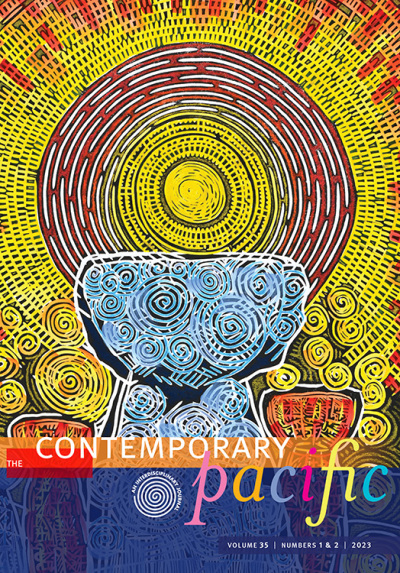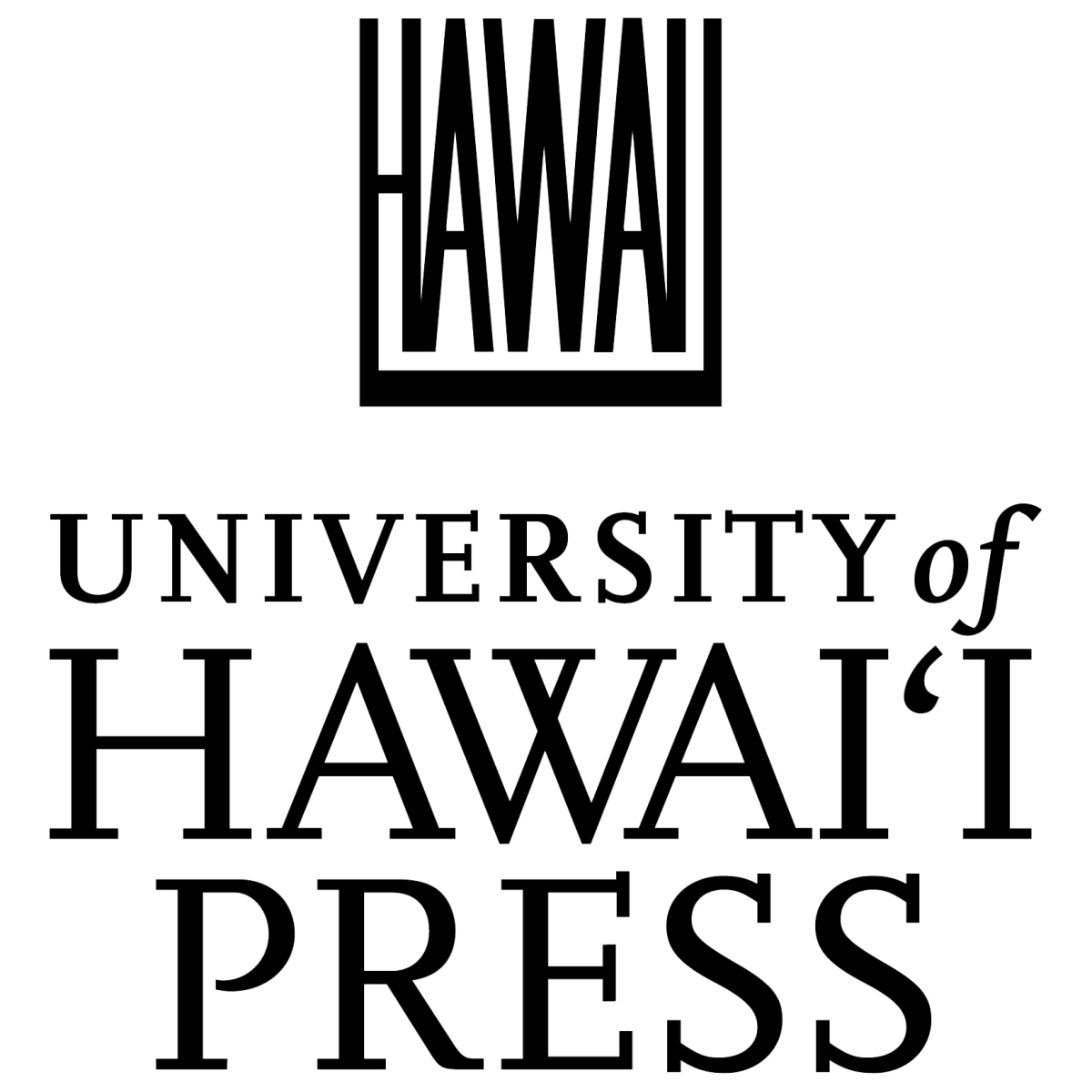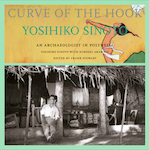2007
 |
 |
|
Spring 19(1) Articles Nemesis, Speaking, and Tauhi Vaha‘a: Interdisciplinarity and the Truth of “Mental Illness” in Vava‘u, Tonga Fashion as Fetish: The Agency of Modern Clothing and Traditional Body Decoration among North Mekeo of Papua New Guinea The Fiji Times and the Good Citizen: Constructing Modernity and Nationhood in Fiji Pacific Islands Trade, Labor, and Security in an Era of Globalization Dialogue Diasporic Deracination and “Off-Island” Hawaiians Survivor Vanuatu: Myths of Matriarchy Revisited Political Reviews Micronesia in Review: Issues and Events, 1 July 2005 to 30 June 2006 Polynesia in Review: Issues and Events, 1 July 2005 to 30 June 2006 Book and Media Reviews Five Takes on Climate and Cultural Change in Tuvalu The Land Has Eyes: Pear ta ma ‘on maf [feature film] Pacific Regional Order, by Dave Peebles; Pacific Islands Regional Integration and Governance, edited by Satish Chand Bougainville: Before the Conflict, edited by Anthony J Regan and Helga M Griffin Ce souffle venu des ancêtres . . . L’œuvre politique de Jean-Marie Tjibaou (1936–1989), by Hamid Mokaddem The Sweet Potato in Oceania: A Reappraisal, edited by Chris Ballard, Paula Brown, R Michael Bourke, and Tracey Harwood Island at the End of the World: The Turbulent History of Easter Island, by Steven Roger Fischer “First Contacts” in Polynesia: The Samoan Case (1722–1848); Western Misunderstandings about Sexuality and Divinity, by Serge Tcherkezoff Island of Angels: The Growth of the Church on Kosrae / Kapkapak lun Church fin acn Kosrae, 1852–2002, by Elden M Buck Decolonizing the Mind: The Impact of the University on Culture and Identity in Papua New Guinea, 1971–1974, by Ulli Beier Vision and Reality in Pacific Religion: Essays in Honour of Niel Gunson, edited by Phyllis Herda, Michael Reilly, and David Hilliard Savannah Flames: Papua New Guinean Journal of Literature, Languages and Culture, Volume 5, edited by Steven Edmund Winduo Expressive Genres and Historical Change: Indonesia, Papua New Guinea and Taiwan, edited by Pamela J Stewart and Andrew Strathern Hiapo: Past and Present in Niuean Barkcloth, by John Pule and Nicholas Thomas Tattoo: Bodies, Art, and Exchange in the Pacific and the West, edited by Nicholas Thomas, Anna Cole, and Bronwen Douglas Life in the Pacific of the 1700s: The Cook/Forster Collection of the George August University of Göttingen [exhibit] Jolika Collection of New Guinea Art, de Young Museum [exhibit] Featured Artist: Shigeyuki Kihara
Shigeyuki Kihara is a visual and performance artist based in Auckland, New Zealand. The recipient in 2003 of Creative New Zealand Art Council’s Emerging Pacific Island Artist Award, her cutting-edge work challenges cultural stereotypes and dominant norms of sexuality and gender. Crossing borders is integral to Kihara’s life. She grew up with a Japanese father and Samoan mother, and in adolescence began occupying the Samoan space (vā) of a Fa‘afafine—a liminal gender category best translated as a male who identifies as a woman. |
Fall 19(2) Uripiv Oral Tradition: The Story of the Eel Articles A Fishy Romance: Chiefly Power and the Geopolitics of Desire The Trouble with ramsi: Reexamining the Roots of Conflict in Solomon Islands Uripiv Oral Tradition: The Last Leseserrkab on Uripiv Dialogue Making a Case for Tongan as an Endangered Language Viewing Diasporas From the Pacific: What Pacific Ethnographies Offer Pacific Diaspora Studies Uripiv Oral Tradition: The Journey of the Dead Resources Imagining Oceania: Indigenous and Foreign Representations of a Sea of Islands Uripiv Oral Tradition: The Two Children Left Behind Political Reviews The Region in Review: International Issues and Events, 2005–2006 Melanesia in Review: Issues and Events, 2006 Uripiv Oral Tradition: The Lebon Brothers Book and Media Reviews The Making of Global and Local Modernities in Melanesia: Humiliation, Transformation and the Nature of Culture Change, edited by Joel Robbins and Holly Wardlow Pacific Futures, edited by Michael Powles Political Parties in the Pacific Islands, edited by Roland Rich with Luke Hambly and Michael G Morgan Globalization and the Re-Shaping of Christianity in the Pacific Islands, edited by Manfred Ernst Conservation Is Our Government Now: The Politics of Ecology in Papua New Guinea, by Paige West Rationales of Ownership: Transactions and Claims to Ownership in Contemporary Papua New Guinea, edited by Lawrence Kalinoe and James Leach Social Discord and Bodily Disorder: Healing among the Yupno of Papua New Guinea, by Verna Keck Les Javanais du Caillou, Des affres de l’exil aux aléas de l’intégration: Sociologie historique de la communauté indonésienne de Nouvelle Calédonie / The Javanese of the Rock: From the Hazards of Exile to the Hazards of Integration, by Jean Luc Maurer, in collaboration with Marcel Magi and with a contribution by Marie-Jo Siban Shifting Images of Identity in the Pacific, edited by Toon van Meijl and Jelle Miedema The People of the Sea: Environment, Identity, and History in Oceania, by Paul D’Arcy Borrowing: A Pacific Perspective, edited by Jan Tent and Paul Geraghty American Pacificism: Oceania in the US Imagination, by Paul Lyons No Turning Back: A Memoir, by E T W Fulton, edited by Elizabeth Fulton Thurston One and a Half Pacific Islands/Teuana ao Teiterana n aba n Te Betebeke: Stories the Banaban People Tell of Themselves/I-Banaba Aika a Karakin oin Rongorongola, edited by Jennifer Shennan and Makin Corrie Tekenimatang The Songmaker’s Chair, a play by Albert Wendt Samoan Wedding and No. 2 [feature films] Pacific Encounters: Art and Divinity in Polynesia, 1760–1860 [exhibition] Featured Artist: Ralph Regenvanu
Ralph Regenvanu’s first public art was unveiled at the time of Vanuatu’s independence in 1980, when he painted the country’s new coat of arms on the wall of Central Primary School, in the capital city of Port Vila. He painted his most famous piece, Las kakae (The Final Feast), when he was taking formal art classes in grade twelve in Australia. Among several inspirations for his art is the storyboard style popular in neighboring Papua New Guinea. From this style he has created a number of drawings, including those in this volume, that highlight custom stories from his family’s home island of Uripiv, off the northeast coast of Malakula. |










